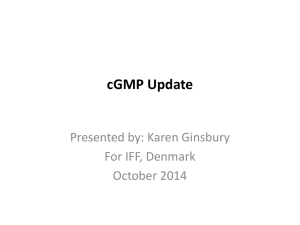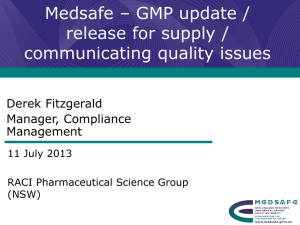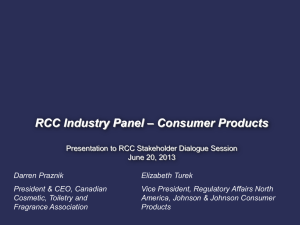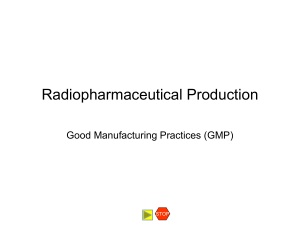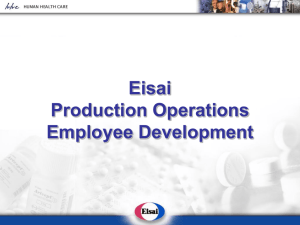QRM on GMP refresher training frequencies
advertisement
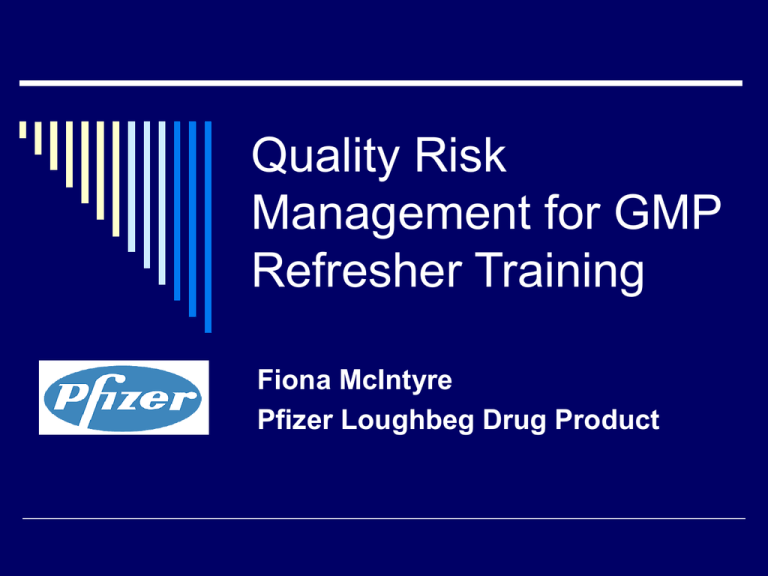
Quality Risk Management for GMP Refresher Training Fiona McIntyre Pfizer Loughbeg Drug Product Why do we do GMP training? FDA “Training in current good manufacturing practices shall be conducted by qualified individuals on a continuing basis and with sufficient frequency to assure that employees remain familiar with cGMP requirements applicable to them” (CFR, 1978). EU “Besides the basic training on the theory and practice of Good Manufacturing Practices,... Continuing training should also be given” (Eudralex, 1997). What does it involve? Companies have reported that they invest between 1 to 12 hours annually per person delivering GMP refresher training (Pharmachem Ireland, 2004). What do participants think? What do participants think? Why is QRM useful ICH Q9 - Quality risk assessments can be used either Reactively e.g. patient impact assessment for a contamination issue Proactively e.g. ascertaining the appropriate frequency for GMP refresher training. Loughbeg DP Model 240 Colleagues 56 Contractors approx e.g. cleaners, security etc GMP refresher frequency – Direct GMP impact – Twice per year (82%) Indirect GMP impact - Once per year e.g. finance (18%) Total Number of hours training 1080 participant hours/year GMP trainer responsible for designing, delivering, scheduling and tracking. QRM Risk Question ‘What is the minimum frequency of GMP refresher training required per functional group to ensure that all colleagues and relevant contractors are cognisant of their responsibilities to the regulators and to our patients in producing product according to GMP and the SISPQ requirements?” SISPQ: Safety, identity, strength, purity and quality (Reference CFR) Out of Scope Training required for a specific need e.g. human error (Deviation system), new regulations/process/system or induction training. Contractors not assigned to job functions will be assessed through the annual GMP plan. Risk Assessment tool Risk Ranking and Filtering Probability of trainees becoming complacent in their knowledge of GMPs resulting in production of product that is not GMP or SISPQ compliant? Severity of impact to product/process/patient if a trainee were to deviate from requirements that ensure GMP and SISPQ compliance due to insufficient training? Probability Factor Weighting Description Low 1 no GMP impact, not responsible for making GMP decisions or performing GMP tasks, they may have read only access to GMP system or infrequent access to GMP areas e.g. HR Med 2 not responsible for making GMP decision or for conducting routine GMP tasks, they may however have access to GMP areas and/or perform GMP related tasks on a on a relatively frequent basis (number of times a week but not daily). e.g. DCC High 3 responsibility for managing GMP systems or involved in GMP decision making, however do not work directly in production or with analysis of product/materials and/ or the operating or cleaning of production equipment. They are responsible for governing systems related to the facility, utilities or process equipment. e.g. PAT Very High 4 responsibility for making GMP related decisions or is directly involved in production and analysis of product or materials and/ or the operating or cleaning of production equipment e.g. QA/ QC/ Manufacturing. Severity Factor Weighting Description: Error or mistake would involve…. low 1 minor nuisance, no effect on quality or GMP, it would be unnoticeable by the customer and have no regulatory impact Moderate 2 low GMP or business impact that could be easily detected or rectified on site immediately. GMP actions performed are verified or controlled by another job function with a higher risk ranking. High 3 possible minor rework or re-inspection; customer may raise a complaint but the error will not result in serious GMP issue or patient safety issue. Very High 4 could lead to adverse patient reaction or non compliance and or serious customer complaint with regulatory implication or recall scenario. Risk Score = Severity x Probability Increasing Probability 4 4 8 12 16 3 3 6 9 12 2 2 4 6 8 1 1 2 3 4 1 2 3 4 Increasing Severity 13-16 Critical – Twice per year 9-12 Major – Once per year 5-8 Minor – Every 18 months 1-4 Non Critical – Every 2 years Category Description 1-4 Non Critical These employees have a low probability of impacting GMP/quality of the product as they are not responsible for GMP decisions or conducting routine GMP tasks. Any errors they could potentially make would have little of no effect on GMP or quality. They generally work in admin roles or roles such as Finance or HR. 5-8 Minor These employees generally have a GMP aspect to their job; however those GMP tasks are verified or controlled by another job role classified as major or critical impact. Employees in this category generally work in roles such as DCC, purchasing etc. Category Description (cont.) 9-12 Major These employees work in a GMP role; however, they work indirectly with product. They are responsible for the GMP systems governing; the facility, utility or equipment used for manufacturing of product. They generally work in roles such as process engineering, calibration etc. 13-16 Critical These employees work directly with manufacturing or testing of product and have the potential to cause serious GMP or quality impact. they work in roles such as Tablet Technician or QC Specialist etc. Worked example…. QC Chemist/Analyst Step 1: Assess ‘what is the probability of colleagues/contractors producing product that is not GMP or SISPQ compliant?’ Result: Very High Score= 4 Rationale: A QC Chemist works directly with the testing and analysis of product on a daily basis and has a very high probability of GMP impact on the product. QC Chemist… Step 2 Assess ‘severity of impact to product/process/patient if a colleague/contractor were to deviate from requirements that ensure SISPQ compliance due to insufficient GMP refresher training?’ Result: Very High Score= 4 Rationale: A QC Chemist has the potential to cause serious quality issues in the course of their work e.g. quality issues as a result of releasing a material with an OOS result. QC Chemist …. Step 3: Calculate risk classification by multiplying the probability score by the severity score (4 x 4 = 16) Step 4: Assign Refresher frequency requirement – Critical classification. Functional Group Probability Severity Result Classification QC Chemist 4 Twice per year 4 16 Assessment of other Job roles Functional Group Probability Severity Result Classification Frequency of GMP Tablet Technicians/Operators Operations Manager QC Specialists QA Specialists 4 4 16 Critical Twice per year AIT Engineers Process Engineers Warehouse Colleagues VTS Specialists 3 4 12 Major Once per year Buyer & Planner QC Assistant Document control Coordinators 2 3 6 Minor Once every 18 months Department Administrators Security EHS HR 1 1 1 Non Critical Once every 2 years Probability Factor Weighting Description Low 1 no GMP impact, not responsible for making GMP decisions or performing GMP tasks, they may have read only access to GMP system or infrequent access to GMP areas e.g. HR Med 2 not responsible for making GMP decision or for conducting routine GMP tasks, they may however have access to GMP areas and/or perform GMP related tasks on a on a relatively frequent basis (number of times a week but not daily). e.g. DCC High 3 responsibility for managing GMP systems or involved in GMP decision making, however do not work directly in production or with analysis of product/materials and/ or the operating or cleaning of production equipment. They are responsible for governing systems related to the facility, utilities or process equipment. e.g. PAT Very High 4 responsibility for making GMP related decisions or is directly involved in production and analysis of product or materials and/ or the operating or cleaning of production equipment e.g. QA/ QC/ Manufacturing. Severity Factor Weighting Description: Error or mistake would involve…. low 1 minor nuisance, no effect on quality or GMP, it would be unnoticeable by the customer and have no regulatory impact Moderate 2 low GMP or business impact that could be easily detected or rectified on site immediately. GMP actions performed are verified or controlled by another job function with a higher risk ranking. High 3 possible minor rework or re-inspection; customer may raise a complaint but the error will not result in serious GMP issue or patient safety issue. Very High 4 could lead to adverse patient reaction or non compliance and or serious customer complaint with regulatory implication or recall scenario. Challenges Devising the descriptions Tracking of the requirement Benefits of the QRM Old requirement = 1080 participant hours/year New requirement = 892 participant hours/year = saving of 18% = 188 participant hours Time – TNA for department specific GMP refreshers. Improved quality of GMP refresher training courses. Shared & implemented across other Pfizer sites increasing the benefit to Pfizer. Questions



